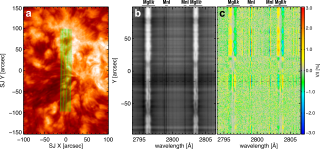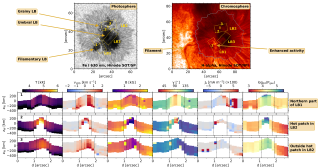We present a visual determination of the number of bright points (BPs) existing in the quiet Sun, which are structures thought to trace intense kG magnetic concentrations. The measurement is based on a 0farcs1 angular resolution G-band movie obtained with the Swedish Solar Telescope at the solar disk center. We find 0.97 BPs Mm-2, which is a factor 3 larger than any previous estimate. It corresponds to 1.2 BPs per solar granule. Depending on the details of the segmentation, the BPs cover between 0.9% and 2.2% of the solar surface. Assuming their field strength to be 1.5 kG, the detected BPs contribute to the solar magnetic flux with an unsigned flux density between 13 G and 33 G. If network and inter-network regions are counted separately, they contain 2.2 BPs Mm-2 and 0.85 BPs Mm-2, respectively.
Advertised on
References
(2010) Magnetic bright points in the quiet Sun. ApJ, 715, L26
It may interest you
-
 The formation and evolution of the disk of our Galaxy, the Milky Way, remains an enigma in astronomy. In particular, the relationship between the thick disk and the thin disk —two key components of the Milky Way— is still unclear. Understanding the chemical and dynamical properties of the stars within these disks is crucial, especially in the parameter spaces where their characteristics overlap, such the metallicity regime around [Fe/H] ~ -0.7, which marks the metal-poor end of the thin disk, higher than that of the thick disk. This is often interpreted as an indication that the thin diskAdvertised on
The formation and evolution of the disk of our Galaxy, the Milky Way, remains an enigma in astronomy. In particular, the relationship between the thick disk and the thin disk —two key components of the Milky Way— is still unclear. Understanding the chemical and dynamical properties of the stars within these disks is crucial, especially in the parameter spaces where their characteristics overlap, such the metallicity regime around [Fe/H] ~ -0.7, which marks the metal-poor end of the thin disk, higher than that of the thick disk. This is often interpreted as an indication that the thin diskAdvertised on -
 The magnetic field in the solar chromosphere plays a key role in the heating of the outer solar atmosphere and in the build-up and sudden release of energy in solar flares. However, uncovering the magnetic field vector in the solar chromosphere is a difficult task because the magnetic field leaves its fingerprints in the very faint polarization of the light, which is far from easy to measure and interpret. We analyse the spectropolarimetric observations obtained with the Chromospheric Layer Spectropolarimeter on board a sounding rocket. This suborbital space experiment observed the nearAdvertised on
The magnetic field in the solar chromosphere plays a key role in the heating of the outer solar atmosphere and in the build-up and sudden release of energy in solar flares. However, uncovering the magnetic field vector in the solar chromosphere is a difficult task because the magnetic field leaves its fingerprints in the very faint polarization of the light, which is far from easy to measure and interpret. We analyse the spectropolarimetric observations obtained with the Chromospheric Layer Spectropolarimeter on board a sounding rocket. This suborbital space experiment observed the nearAdvertised on -
 Light bridges are elongated and bright structures protruding into the umbra of sunspots. The presence of light bridges has a significant role in the evolution of sunspots and the heating of their overlying atmosphere. Therefore, investigating these structures is crucial to understanding fundamental aspects of sunspots. By applying a novel code based on deep-learning algorithms called SICON to spectropolarimetric observations acquired with the Hinode satellite, we computed atmospheric parameters that allowed us to infer the variation of the physical properties of light bridges on a geometricAdvertised on
Light bridges are elongated and bright structures protruding into the umbra of sunspots. The presence of light bridges has a significant role in the evolution of sunspots and the heating of their overlying atmosphere. Therefore, investigating these structures is crucial to understanding fundamental aspects of sunspots. By applying a novel code based on deep-learning algorithms called SICON to spectropolarimetric observations acquired with the Hinode satellite, we computed atmospheric parameters that allowed us to infer the variation of the physical properties of light bridges on a geometricAdvertised on